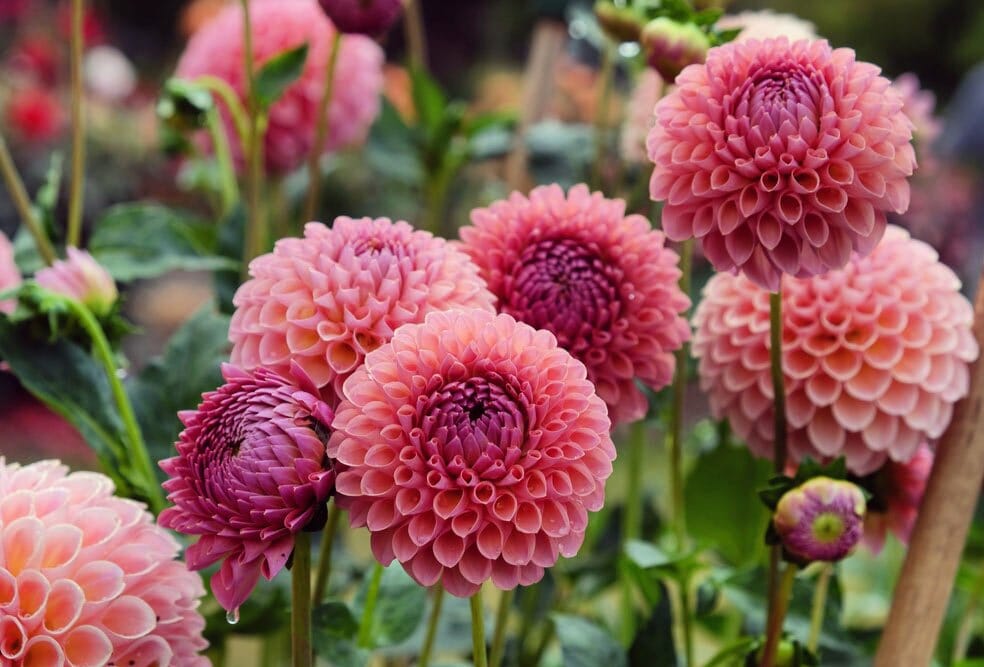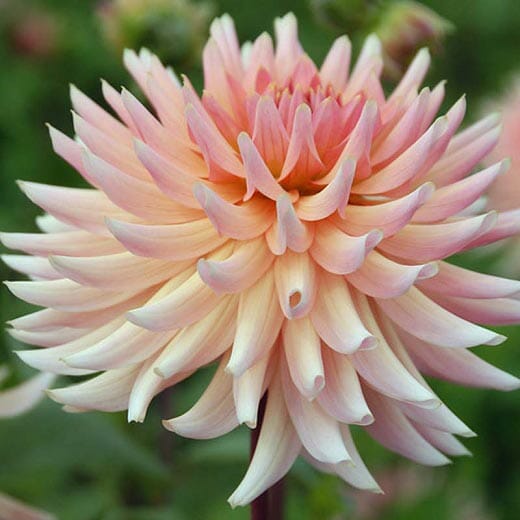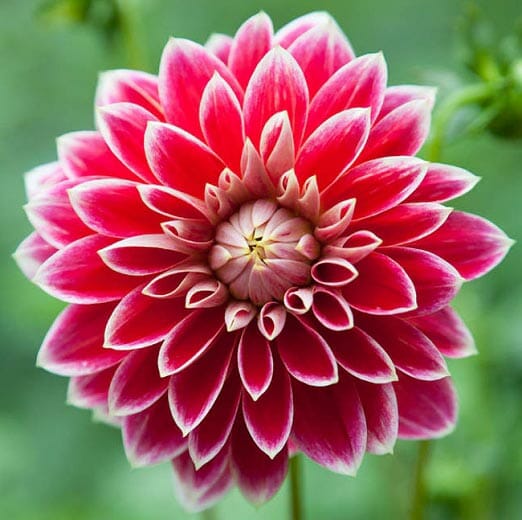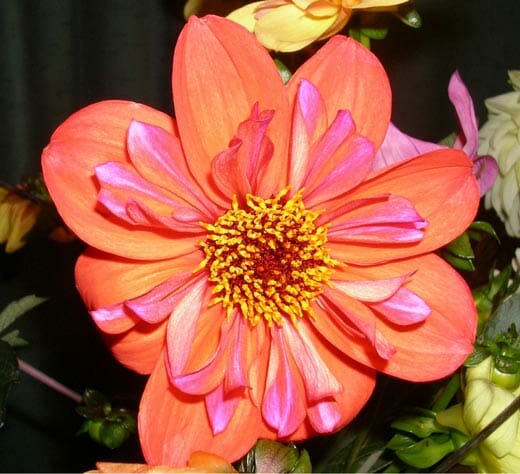Dahlias are known for their intense colors and symmetrical ball-like shape. They have been a hit across Europe since the late nineteenth century.
It was at the end of the eighteenth century before the Dahlia reached Europe and soon after three varieties were known. Between 1830 and I860 the interest in Dahlias became intense, and great premiums were paid for good varieties. Then in 1870 followed varieties that were flatter, less formed, and delicately colored. In 1872 a new species, Dahlia Jaurezii, was introduced. This is the progenitor of the Cactus Dahlia, a type universally admired.
The Cactus types are combined with the singles to”produce the Peony-flowered forms from which have been eliminated the week stems, resulting in an exalted form, and good, shaped blooms of matchless colors borne upon wonderfully strong plants.

Types of Dahlias
The American Dahlia Society’s classification of Dahlias may be of interest for reference: https://www.dahlia.org/guide/
Cactus Dahlias
A. TRUE, FLUTED TYPE: Flowers fully double; floral rays (“petals”) long, narrow, incurved or twisted, with sharp, divided, or fluted points and with revolute (“rolled back”) margins, forming, in the outer florets, a more or less perfect tube for more than half the length of the ray.
Typical examples: Snowdon, T. G. Baker, Mrs. Douglas Fleming, J. H. Jackson, H. H. Thomas, and Rev. T. W. Jamieson.

Hybrid-cactus or Semi cactus variety
Flowers fully double; floral rays (“petals”) short as compared with the previous type, broad, flat, recurved or twisted, not sharply pointed except when tips are divided (“staghorn”), margins only slightly revolute (“rolled back”), and tubes of outer florets, if any, less than half the length of the ray.
Typical examples: Master Carl, Perle de Lyon, Flora, Mrs. J. T. Mace, Kalif, and Rheinkoenig.
Decorative Dahlias
Double flowers, full to center in the early season, flat rather than ball-shaped, with broad, flat, somewhat loosely arranged floral rays “.petals”) with broad points or rounded tips which are straight or decurved (turned down or back), not incurved, and with margins revolute (rolled back) if rolled at all.
Includes forms like those of Souvenir de Gustave Douzon, Jeanne Gharmet, Le Grand Manitou, Delice, Lyndhurst, and Bertha Von Suttner, but does not include Le Golosse, Mrs. Roosevelt, Dreer’s White, Grand Duke Alexis, or similar forms, which fall into section B. of the ball-shaped double Dahlias.
Dahlias are a perfect addition to any garden and really make a home pop with a freshly cut lawn and a garden bed full of color.

Ball-shaped double Dahlias
A. SHOW TYPE: Double flowers, globular or ball-shaped rather than broad or flat, full to center, showing regular spiral arrangement of florets; floral rays more or less quilled or with markedly involute (rolled in) margins and rounded tips.
(The class called Fancy Dahlias is not recognized separately in this classification, but is included in this Sub-section A.)
Typical examples of Show Dahlias: Arabella, Dorothy Peacock, Gold Medal, John Walker, Colonist, and A. D. Livoni.
B. HYBRID SHOW, GIANT SHOW OR COLOSSAL TYPE: Flowers fully double, broadly hemispherical to flatly globular in form, loosely built so spiral arrangement of florets is not immediately evident; floral rays (“pet- als”) broad, heavy, cupped, or quilled, with rounded tips and involute (rolled in or forward) margins.
Typical examples: Grand Duke Alexis, Cuban Giant, Mrs. Roose- velt, Le Colosse, W. W. Rawson and Golden West.
G. POMPON TYPE: Shape and color may be same as of A. or B.; but must be under two inches in diameter.
Typical examples: Fairy Queen, Belle of Springfield, Darkest of All, Nerissa, Little Herman, and Snowclad.
Peony-flowered or Art” Dahlias
Semi-double flowers with an open center, the inner floral rays (“petals”) being usually curled or twisted, the other or outer petals being either flat or more or less irregular. Typical examples: Queen Wilhelmina, Geisha, Hampton Court, Mrs. W. Kerr, P. W. Janssen, and Glory of Baarn.

Duplex Dahlias
Semi-double flowers, with the center, always exposed on the opening of buds, with petals in more than one row, more than 12, long and flat, or broad and rounded, not noticeably twisted or curled. (Many so-called Peony-flowered Dahlias belong here.)
Typical examples: Big Chief, Souv. de Franz Listz, Merry Widow, Sensation, Prairie Fire, and Hortulanus Budde.
Single Dahlias
Open centered flowers, small to very large, with eight to twelve floral rays (“petals”) more or less in one circle, margins often decurved (turned down or back). There are no distinctions as to colors. The type embraces the large Twentieth Century as well as the smaller English varieties.
Typical examples: White Century, Golden Century, Scarlet Century, Newport Marvel (of the large-flowered forms); with Polly Eccles, Leslie Seale, Danish Cross and Ami Barillet (of the lesser flowered forms).
The Star singles and Cactus singles are omitted from the present classification scheme as not being sufficiently numerous or well defined yet.
Collarette Dahlias
Open centered blossoms with not more than nine floral rays (“petals”), with one or smaller rays, usually of a different color, from the heart of each ray floret, making a collar about the disk.
Typical examples: Maurice Rivoire, Souvenir de Chabanne, Diadem, Orphee, Madame Poirier and Albert Maumene.

Anemone-Flowered Dahlias
Flowers with one row of large floral rays (“petals”) like single Dahlias, but with each disk flower producing small, tubular petals.
Includes such forms as those of Graziella, Mme. Chas. Molin, Claude Barnard, and Mme. Pierre Dupont.
Miniature or Pompon Cactus
Small flowered, stellate fine petaled cactus Dahlias represented by Tom-tit, Mary, Nora, Minima. MIGNON OR TOM THUMB: Dwarf, bushy, single-flowered Dahlias for edging. A typical example: Jules Closson.
Bedding Dahlia
A taller, more upright type than the Tom Thumb. Typical examples: Barlow’s Bedder and Midget Improved.
Cockade of Zonal Dahlias
Single or collarette Dahlias, with three distinct bands ‘of color about the center. Type hardly known hi America, but includes forms such as those of Cockade Espagnole
Dahlia Cultivation
The Dahlia is typically Fall blooming and succeeds in any location where killing frosts do not come too early. If the plants are not seriously checked in their growth by frosts, they will usually bloom very nicely in most parts of New York State, New England, and the Central West. The soils best adapted to Dahlias are those which are somewhat -sandy, but they will grow on heavy clay. The regions which are influenced more or less by the ocean, that is, where cool nights are prevalent, are perhaps the most noted for Dahlia growing, especially Long Island, New Jersey, Rhode Island, Maryland, and Massachusetts in the East, and without a doubt, the best Dahlias we have ever seen were in British Columbia, Northern California, Washington and Oregon. Heavy soils may be lightened by coal ashes. Sand and lighter soils will benefit from manure to make them more moisture-retaining. Nitrogenous fertilizers are rarely applied because they cause too great vegetative growth and a retarding of the flowering period.
Starting Dahlia Tubers
The tubers should be started about April 1st in a warm, lightroom, merely placing them in a shallow box of sand or light soil. When the young shoots begin to show, they should be so cut that one or two eyes are allowed to remain on each piece; the eyes start from the collar.
To Attain Large Flowers
If the soil is carefully and diligently cultivated there will be little need for watering, which is detrimental unless consistently practiced. Thorough watering should be given each time and at regular intervals; otherwise, plants will be checked and flowers will suffer.
In order that each individual flower may be as large as possible, especially in the case of the show and fancy types, which produce a great many flowers of medium size, it is best to disbud the main branches leaving only the terminal bud. It is often best to allow only six or eight branches. The singles, collarettes, and pompons are rarely pruned or disbudded, the idea is to get plants with as many flowers as possible. The cactus varieties are apt to have their weak neck habit intensified by excessive pruning and de-budding so that they should be cautiously disbudded, removing only part of the buds.
Flowers are best cut in the morning or evening and any foliage not wanted should be removed. The stems should then be placed in water up to the base of the flowers and removed to a cool place. Hard-stemmed varieties are best placed in hot water and allowed to remain until the water cools when they should be removed to fresh cold water. Under no circumstances attempt to ship for exhibition without the pre-cooling.
Why You should grow Dahlias
Dahlias will always make a successful appeal to the affections of the amateur gardener, first because of the comparative simplicity of its culture, but chiefly because, at a period of the year when the summer denizens of the flower garden are beginning to bear traces of wear and tear, and are preparing either for their winter rest or their demise, the dahlia is just coming into bloom.
If the weather is at all propitious, there is a certainty that it will produce a wealth of gorgeous flowers over a period of many weeks and that it will help to make the early autumn garden gay until the first severe frost pronounces its doom.
For the purposes of classification, the dahlia family may be divided into six sections.
These are: (1) cactus, (2) show and decorative, (3) paeony-flowered, (4) pompon, (5) single, (6) Tom Thumb. A moderate-sized volume could be filled in enumerating the thousands of varieties that are included in growers’ catalogs, but for the guidance of the amateur gardener, it will be sufficient to indicate in the following tables a few of the newest varieties worthy of his attention, as well as those that are suitable for exhibition, if he entertains ambitions in that direction.
Dahlia Propagation
There are three principal methods of propagating the dahlia, as follows :
- By seed sowing,
- By cuttings.
- By division.
Raising Dahlias from Seed
This is fascinating work, particularly the single forms. Of these, if the seed is sown in a frame or greenhouse in March, the plants will come into bloom in July; they will also flower if the seed is sown where it is to remain, the same as most of the annuals. The seed of the double Dahlias should be sown in February or March, and the plants are grown on the same as if from cuttings.
With good care, they will come into flower early in September, when the pleasure commences. The certainty of getting something good, and the possibility of getting a flower worthy of a name, possibly better than any of the existing forms or varieties, makes this branch of floriculture more interesting than any other.
The young seedlings should be set close together, not more than two feet apart; when they come into flower weed out such as are not desirable to keep. Another reason for close planting is that the plants do not attain in their first season as large growth as if from tubers. This does not apply to the single forms, which reach their limit of size the first season.
see Propagating dahlia for extensive Dahlia propagation instructions.
Dahlia Care
If the best results are to be obtained dahlias will require a little careful attention throughout the summer. Towards the end of July, the plants will be growing rapidly, and this is the time to thin out the shoots. If large, handsome flowers are desired, and especially if the grower has any intention of exhibiting, it will be sufficient to confine the plant to one main stem.
Nearly all the side shoots should be removed. Moreover, as soon as the early flower buds appear they should be rigorously thinned, and at this stage, liquid manure may be given to the plants at each alternate watering. Further aid in increasing the productivity of flowers may be found in liberal mulching of short, decomposed manure.
Planting Dahlias
The dahlia requires plenty of room, and therefore, while not discarding it altogether for the purposes of the mixed border, I find that it pays to devote a bed of considerable size exclusively to its cultivation. The soil is well prepared beforehand. Very soon after the last clump of tubers has been lifted in the autumn the ground is deeply dug, and the surface left rough during the winter, so that the atmosphere may do its part in fertilizing and sweetening the soil. In March the ground is again dug over and broken up, and at the same tune, a good quantity of rich stable manure is incorporated with the soil. A week or so before planting-out time circular holes two feet in diameter and eighteen inches deep are dugout, a few forkfuls of manure are placed in the bottom of the hole, and covered with fine soil.
When the time comes for planting, a smaller hole, but one of sufficient size to take the base of roots comfortably, should be made with a trowel, and the dahlia carefully removed from the pot so as not to injure the roots. The plant, with the ball of earth attached, should then be inserted in the ground, adequate care is taken that the base of the roots rests firmly on the bottom of the hole prepared for it. Next, the soil should be pressed around the roots, and a nice even surface is made.
Time and Distance of Planting
They may be planted late in April or May, according to the season. It is better to set them out late than too early. As the Dahlia makes a large plant it should be given plenty of room; even four feet by four feet is not too much if the variety is a large one. Planted much closer the plants are difficult to tend.
Supporting Dahlias
Use some method of support immediately when the plants are set so that they may be “brought up in the way they should go” from the very start. The average root will make several shoots.
Allow them to grow until they make the first set of leaves; by that time the strongest can be selected and the others cut away below the surface of the soil. Sometimes two shots may be allowed to grow, but never more; as a rule one shoot is sufficient. Tie the shoot to the stake when about a foot high and do not neglect to tie as the plant develops, for this is very important.
Staking Dahlias
Staking is an important operation, and this should be done at the same time as the planting. Use good stout stakes. The dahlia is a heavy plant and needs to be safeguarded adequately against the buffeting of high winds. Thrust the stake a foot or so into the ground, as near as possible to the roots of the plant without damaging them, and then securely tie the main stem to the stake with bass or raffia tape.
Dahlia Pests
It will be necessary also to keep a sharp look-out for the earwig one of the most persistent enemies of the dahlia. The commonest and not the least effectual method of trapping them is to fill small flower-pots with hay and place them, inverted, on the top of the stakes to which the plants are tied. The pots should be examined every morning and the earwigs shook out on the garden path and destroyed.
Dahlia End of Season Care
With the arrival of the first sharp frost in autumn, the glory of the dahlia will depart. You will wake up one fine crisp morning in late October, to find your dahlia flowers hanging limp, and the stems a seared and blackened mass. Then the question arises, What shall be done with the tubers that have been formed at the base of the plants?
The grower is naturally anxious to save them for purposes of propagation in the following spring, and if he has had no previous experience in the cultivation of dahlias he very naturally desires to know whether it is safe to leave them in the ground throughout the winter months. As a general rule for most parts of the country, I should strongly advise against running the risk of disaster, which the left of the tubers in the ground involves.
The dahlia is not a hardy plant, though it is a perennial. The newly-formed tubers at the base of the plant are succulent and sappy, and if they are left undisturbed in the ground a prolonged spell of frost will ruin them. They will become blackened masses and will rot away. In warm and unexposed places it may be possible to preserve dahlia roots in the ground during a mild winter by covering their resting-place with a good thick layer of littery manure or ashes; but if it is desired to maintain the stock the risk is too great to be run even when these precautions are adopted.
What, then, is the best plan to follow? As soon as the first severe frost has blackened the stems they should be cut down to within six inches of their bases. Next with a spade cut niches six or eight inches deep around the extremity of the tubers. This will facilitate the process of lifting, which should be done with the utmost care, so as to avoid either cutting or bruising the tubers.
As each plant is lifted tie to one of the stem stumps a stout label bearing a legible record of the name and color of the variety. It is essential that this be done, otherwise, there will be endless confusion when the time comes in the next year to begin the operation of propagation.
When all the plants have been lifted and labeled carefully spread them out on a mat or a piece of sacking on the floor of a dry, frost-proof shed or greenhouse. Here they should be allowed to remain for a few weeks until they are thoroughly dry. Afterward, they may be further cleaned by the removal of any superfluous soil that still remains attached to the roots, and they should then be placed in deep boxes and covered lightly with sand or dry moss.
The chief essential now is to keep the tubers away from all possibility of damp and frost reaching them. Therefore a bad practice should be avoided at all costs. This is to place the tubers under a greenhouse bench, where they will inevitably be ” damped off ” if the drip due to watering plants above them be allowed to fall continually upon them. If there be no greenhouse accommodation for the storage of the tubers they may be placed with perfect safety in a dry cellar or loft. Here they should be allowed to remain until February when the time for propagation by means of cuttings will have arrived.






